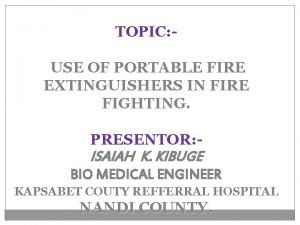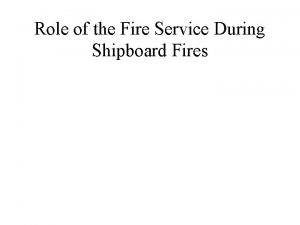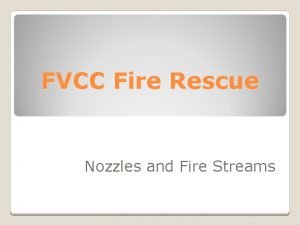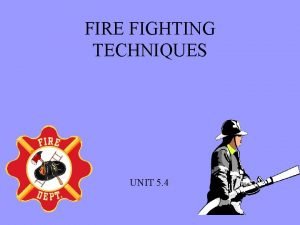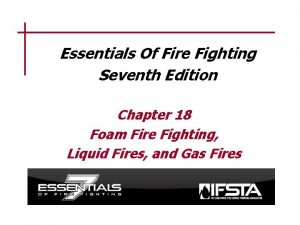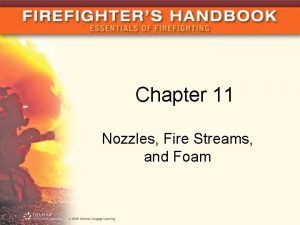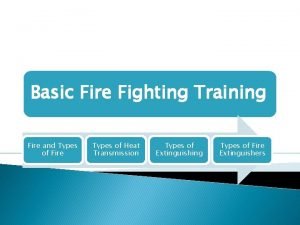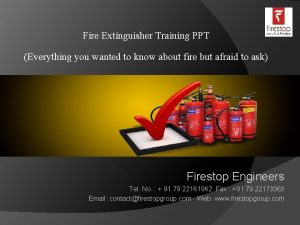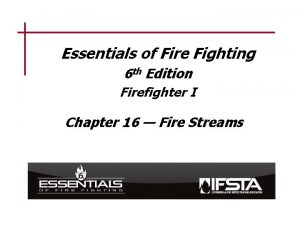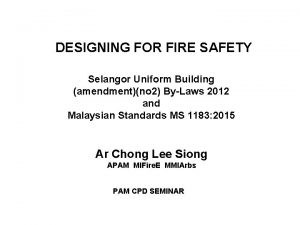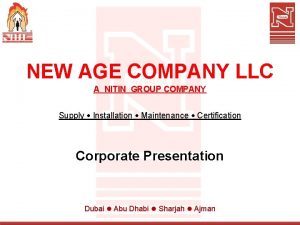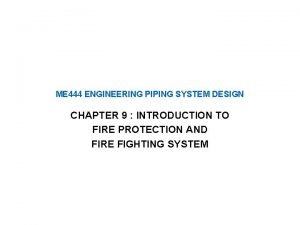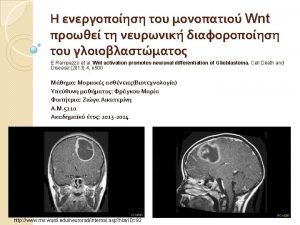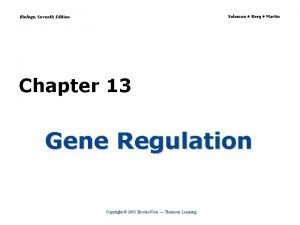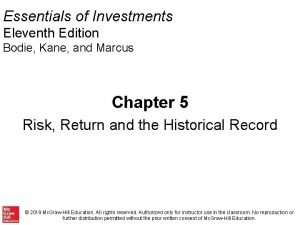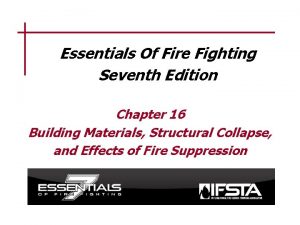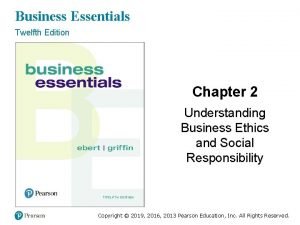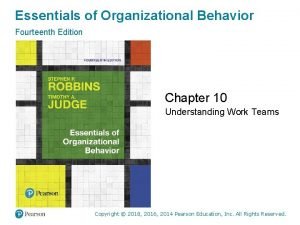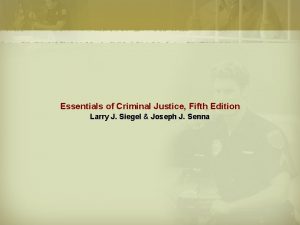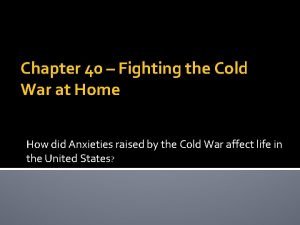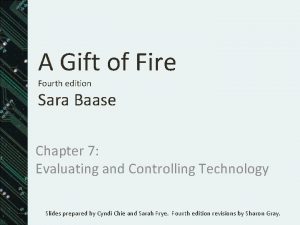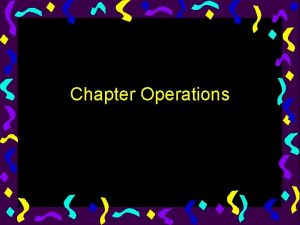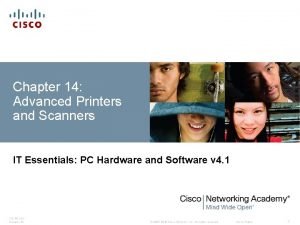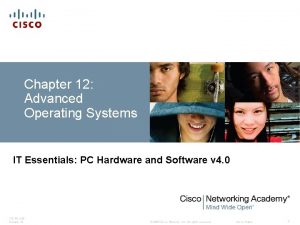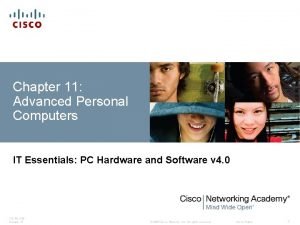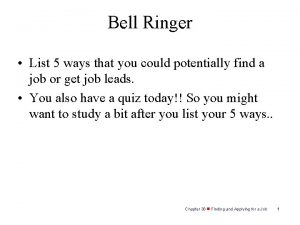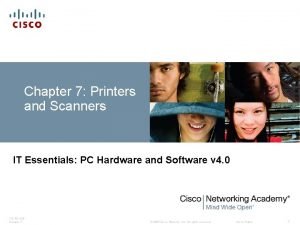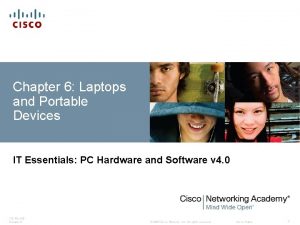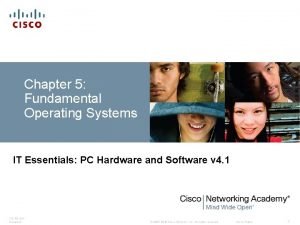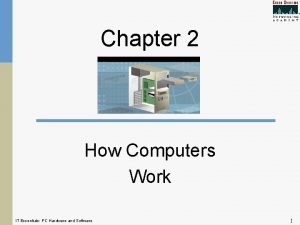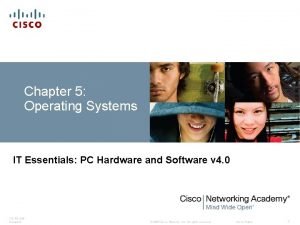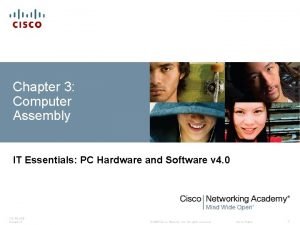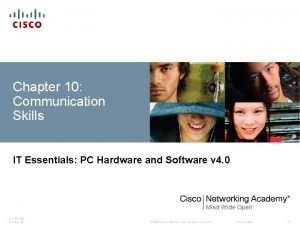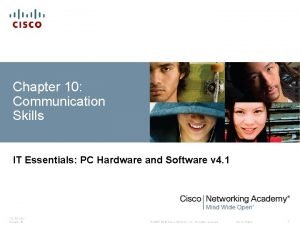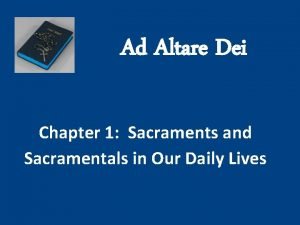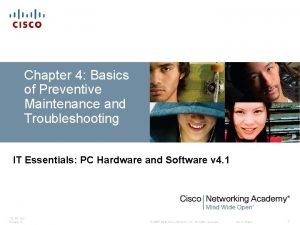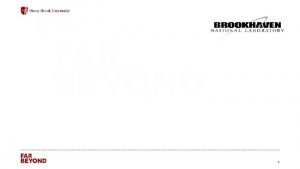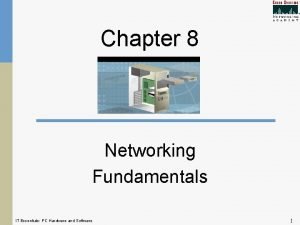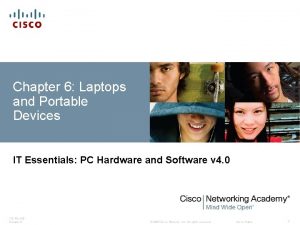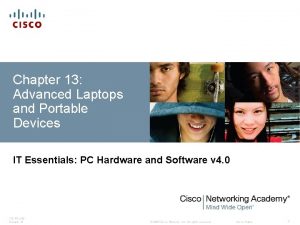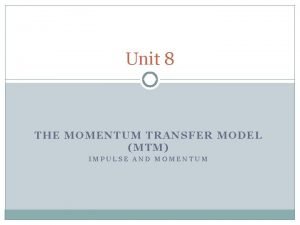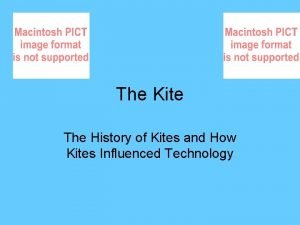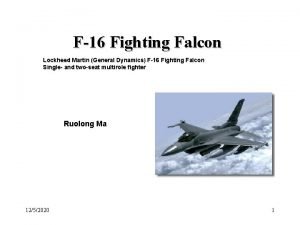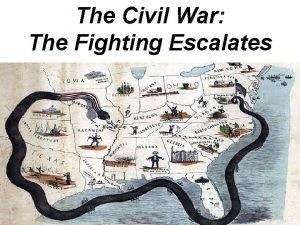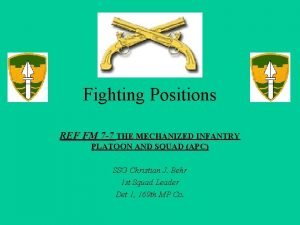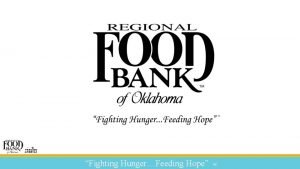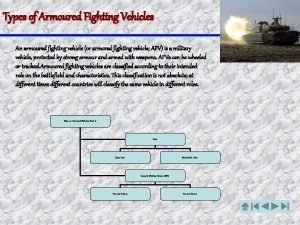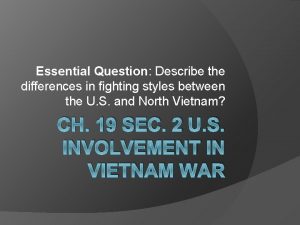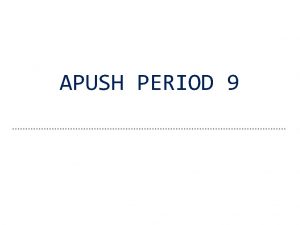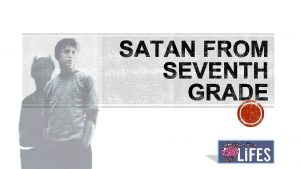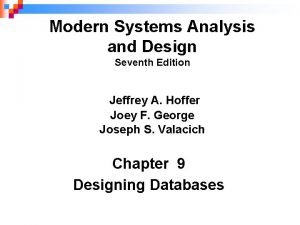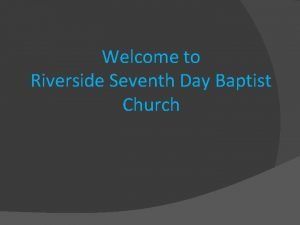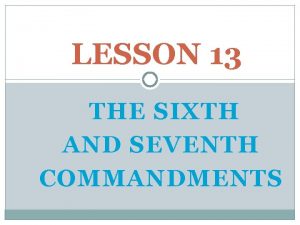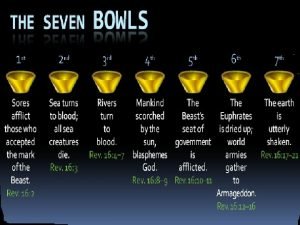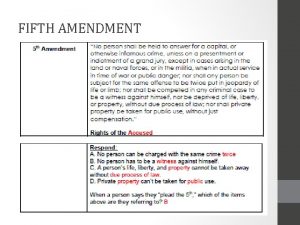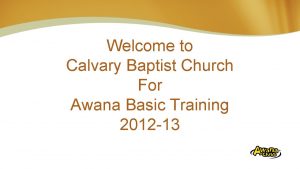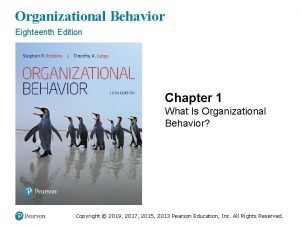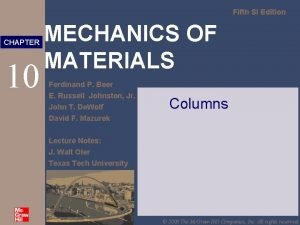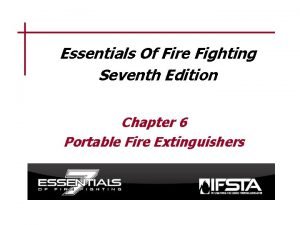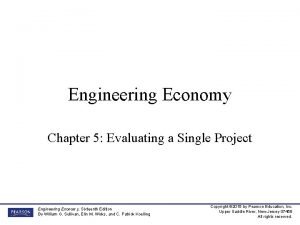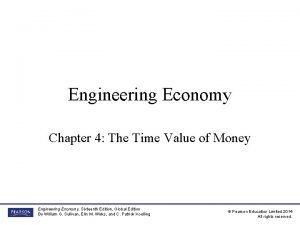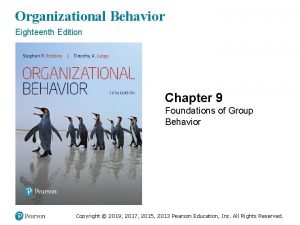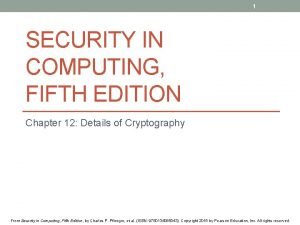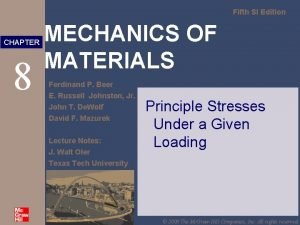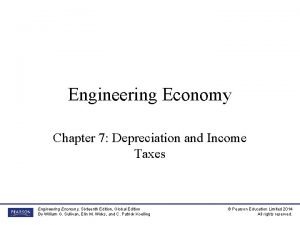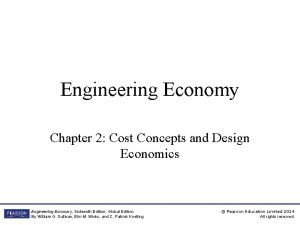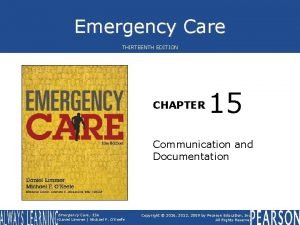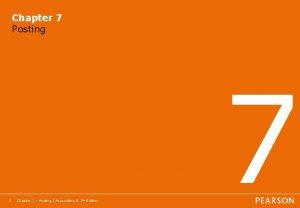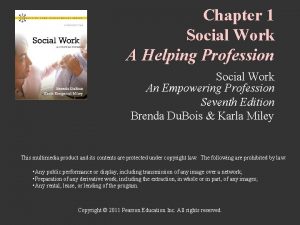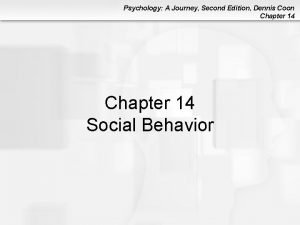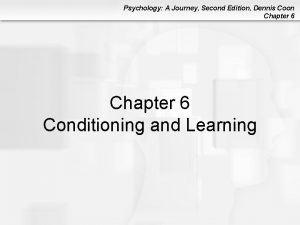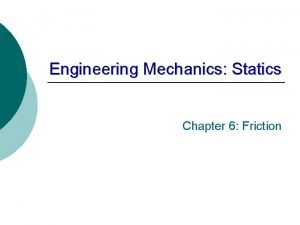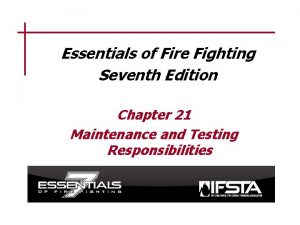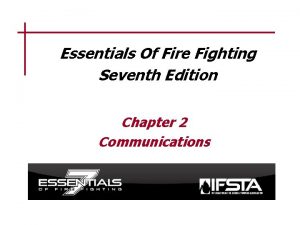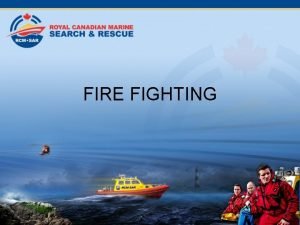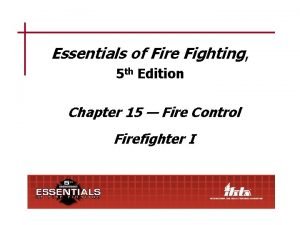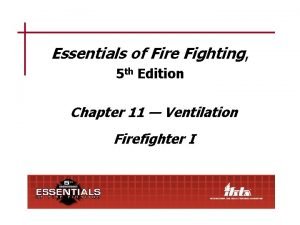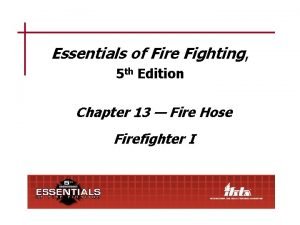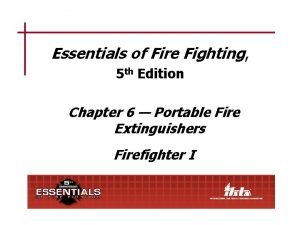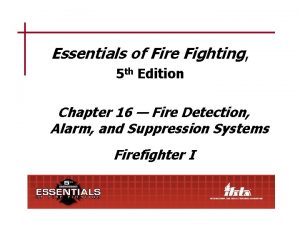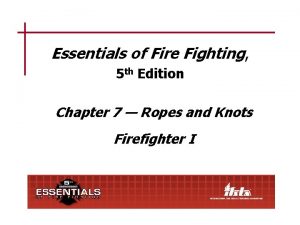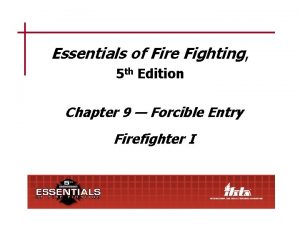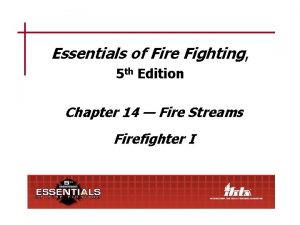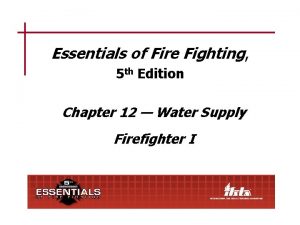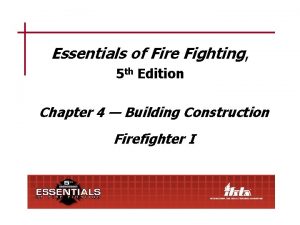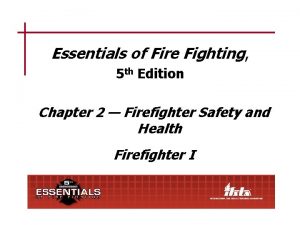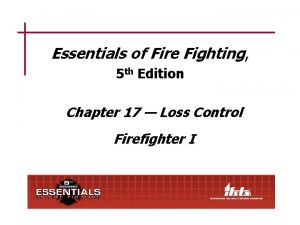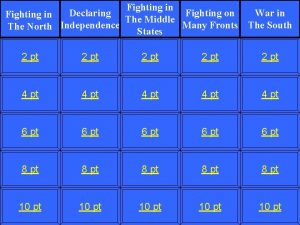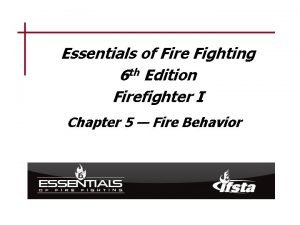Essentials Of Fire Fighting Seventh Edition Chapter 1



























































































































































- Slides: 155

Essentials Of Fire Fighting Seventh Edition Chapter 1 Introduction to the Fire Service and Firefighter Safety

Learning Objective 1 Explain the mission of the fire service. 1– 1

Fire Service Mission AHJ determines services needed to protect citizens and establishes fire service to meet the needs Different communities require different services Vary among cities, states/provinces, regions (Cont. ) 1– 2

Fire Service Mission Protect property and the environmen t Save lives 1– 3

All-Hazard Concept Approach To Fire Protection Structural fire suppression courtesy of Bob Esposito 1– 4

Fire Department Mission Statement Part of department’s rules and regulations Should be posted in every facility and made available to personnel and the community 1– 5

REVIEW QUESTION What is the overall mission of the fire service? 1– 6

DISCUSSION QUESTION What are some community needs in your jurisdiction that may affect the fire service mission? 1– 7

Learning Objective 2 Describe how fire departments are organized. 1– 8

AHJ Establishes Organization Of The Fire Department Type of department Number and location of facilities Types and number of apparatus Organizationa l hierarchy Number of personnel Minimum training and certification levels Functions and responsibilitie s 1– 9

Scalar Organizational Structure Feedback and information Decisions and information 1– 10

Organizational Principles Division of labor Chain of command Unity of command Discipline Span of control 1– 11

Chain of Command Unity of Command 1– 12

Span Of Control 1– 13

Discipline and Division Of Labor Discipline Division of labor • Organization provides leadership • Individual follows orders • Rules, regulations, and policies define acceptable performance and expected outcomes • Dividing large jobs into smaller jobs • Necessary to assign responsibility and prevent duplication of effort 1– 14

Types Of Fire Departments Public departmen ts Private departmen ts (Cont. ) 1– 15

Types Of Fire Departments Career Voluntee r Combinati on 1– 16

Fire Companies Operations division Battalion or response district Multiple companies • Apparatus and firefighters • Organized based on local needs (specialized or performs multiple functions) (Cont. ) 1– 17

Fire Companies Engine company Truck (Ladder) company Rescue company Brush company Hazardous materials company Emergency medical/ambulance company Aircraft rescue and fire fighting (ARFF) company 1– 18

Classifications Of Fire Department Personnel Career Volunte er Line personn el 1– 19 Staff personn el

REVIEW QUESTION How are fire departments organized? 1– 20

DISCUSSION QUESTION How are fire departments organized in your jurisdiction? 1– 21

Learning Objective 3 Describe the various specializations within the fire service. 1– 22

Criteria For Fire Fighter I And Fire Fighter II NFPA 1001 NFPA 1582 Professional qualifications Medical requirements AHJ Educational requirements Age requirement Physical fitness requirements 1– 23

Basic Necessary Medical Care Skills Cardiopulmonary resuscitation (CPR) Bleeding control Infection control Shock management Departments may require certification for EMS First Responders, EMT, or paramedic candidates 1– 24

Standards For Fire Fighting Specialties 1– 25 (Cont. )

Standards For Fire Fighting Specialties 1– 26

Fire Fighter I And II Training • • Fire suppression Search and rescue Extrication Ventilation Salvage Overhaul EMS Hazardous materials 1– 27

Differences Between Fire Fighter I And Fire Fighter II Fire Fighter I • Under direct supervision of Fire Fighter II or company officer Fire Fighter II • Trained to coordinate Fire Fighter I and Fire Fighter II under supervision of company officer • Performs more complex tasks • Assumes and transfers command within ICS 1– 28

Fire Service Specialties Apparatus Driver/opera tor Hazardous materials technician Rescue technician Airport firefighter Wildland firefighter EMS personnel 1– 29

Fire Service Officers Company officers Incident safety officers Health and safety officers District/Battalion chiefs Assistant/Deputy chiefs Fire marshals Fire chief 1– 30

Fire Prevention Division Deals with the public • Building inspections • Code enforcement • Plans review • Community risk reduction (CRR) Headed by chief officer or designated role 1– 31 (Cont. )

Fire Prevention Division Positions • Fire prevention officers/inspectors • Plans examiners • Fire and arson investigators • Fire and life safety educators • Fire protection engineers/specialists 1– 32

Training Division Provides training to personn el • Entry level • Certification training • Refresher courses Specialized courses may be provided by state/provincial, regional, national academies 1– 33 Positions • Instructors • Training officer/chief of training

REVIEW QUESTION What specialized jobs and divisions exist within the fire service? 1– 34

DISCUSSION QUESTION What specialized jobs within the fire service interest you? Why? 1– 35

Learning Objective 4 Describe fire department SOPs, rules, and regulations that affect a Fire Fighter I. 1– 36

Written Regulations Clarify expectatio ns Delegate authority Assign responsibili ty Policies and procedures Municipal ordinances State/provincial and federal laws AHJ codes and standards Labor contracts 1– 37

Learn And Adhere To Department Regulations Firefighters have responsibility to learn and adhere to department regulations • Be able to locate documents • Find parts that apply to duties, authority, and responsibility Organizations must provide access to regulations • Written or electronic format • Communicate verbally to all members • Post in conspicuous place in all facilities 1– 38

Finding Regulations Ask supervisor Copy in each station, facility, or division Always filed in administrati ve office 1– 39 New policies or amendment s posted on bulletin boards

Policies • Guide to decision making within • • • organization Distributed from top management Set boundaries and establish conduct standards Address specific issues May be created in response to government mandates May be written or unwritten 1– 40

Procedures Detailed written plans that list specific steps for a problem or situation Standard operating guidelines (SOGs) Standard operating procedures (SOPs) 1– 41

REVIEW QUESTION What types of written regulations affect firefighters? 1– 42

DISCUSSION QUESTION Why do you think that SOPs are critical to the fire service? 1– 43

Learning Objective 5 Explain ways that fire departments may interact with other organizations and agencies. 1– 44

Interaction With Other Agencies And Organizations EMS organizations • Provide complete medical services • Supplemental medical services provided by fire department Local hospitals • Assist by radio • Dispatch medical professionals to the scene (Cont. ) 1– 45

Interaction With Other Agencies And Organizations Emergency/Disast er management Law enforcement • Coordinate multiagency activities • May be local, state/provincial, or federal • Scene security • Traffic and crowd control • Firefighter protection • Fire investigation • Explosives disposal (Cont. ) 1– 46

Interaction With Other Agencies And Organizations Utility companies and public works Media • Shutting off utilities • Oversee construction of roads, buildings, sewers • May manage hydrants and hydrant testing • Alert public of traffic incidents, evacuations, or fire department activities • Inform public about fire and life safety topics and initiatives 1– 47

REVIEW QUESTION How do fire departments interact with other organizations and agencies? 1– 48

DISCUSSION QUESTION What are examples of organizations and agencies within your community that the fire service may need to interact with? 1– 49

Learning Objective 6 Explain the roles and duties of a Fire Fighter I. 1– 50

Incident Priorities Life safety Incident stabilization Property conservation 1– 51

Emergency And Nonemergency Duties Of A Fire Fighter I Required By NFPA 1001 • • Establish work areas at emergency scenes Force entry into structures Set up and use ground ladders Extinguish fires Conduct search and rescue Overhaul a fire scene Set up electrical and lighting equipment (Cont. ) 1– 52

Emergency And Nonemergency Duties Of A Fire Fighter I Required By NFPA 1001 • Tie knots for hoisting tools • Connect pumpers to hydrants and perform • • • hose lays Turn off building utilities Route emergency and nonemergency telephone calls Communicate over department radios Clean, inspect, and maintain equipment Prepare apparatus hose loads 1– 53

REVIEW QUESTION What is the role of a Fire Fighter I? 1– 54

Learning Objective 7 Describe fire and life safety initiatives aimed at reducing firefighter illnesses, injuries, and fatalities. 1– 55

Firefighter Injuries And Fatalities Highest risk factor to firefighters is cardiac arrest as a result of • Overexertion • Poor health habits • Occupational stress Firefighters also injured and killed • In motor vehicle incidents • As result of emergency scene hazards 1– 56

Firefighter Injuries And Fatalities Information Sources § NFPA® § United States Fire Administration (USFA) § National Institute for Occupational Health and Safety (NIOSH) § Occupational Safety and Health Administration (OSHA) § National Near-Miss Reporting System § National Institute of Standards and Technology (NIST) 1– 57

NOTE Reporting in Canada is performed at the provincial or territorial level. Canada has no national reporting system. 1– 58

The National Fallen Firefighters Foundation (NFFF) NFFF Mission "To honor and remember America's fallen fire heroes, to provide resources to assist their survivors in rebuilding their lives, and work within the Fire Service Community to reduce firefighter deaths and injuries" 1– 59

NFFF 16 Firefighter Life Safety Initiatives Provide fire service a blueprint for making changes Work to establish training on Fire and Life Safety Initiatives throughout the fire service in the U. S. Also known as Everyone Goes Home® (Cont. ) 1– 60

NFFF 16 Firefighter Life Safety Initiatives 1. Define and advocate the need for a cultural change relating to safety; incorporating leadership, management, supervision, accountability and personal responsibility 2. Enhance personal and organizational accountability for health and safety 3. Focus greater attention on integration of risk management with incident management at all levels, including strategic, tactical, and planning responsibilities (Cont. ) 1– 61

NFFF 16 Firefighter Life Safety Initiatives 4. All firefighters must be empowered to stop unsafe practices 5. Develop and implement national standards for training, qualifications, and certification (including regular recertification) that are equally applicable to all firefighters based on the duties they are expected to perform 6. Develop and implement national medical and physical fitness standards that are equally applicable to all firefighters, based on the duties they are expected to perform 1– 62 (Cont. )

NFFF 16 Firefighter Life Safety Initiatives 7. Create a national research agenda and data collection system that relates to the initiatives 8. Utilize available technology wherever it can produce higher levels of health and safety 9. Thoroughly investigate all firefighter fatalities, injuries, and near misses 10. Grant programs should support the implementation of safe practices and/or mandate safe practices as an (Cont. ) eligibility requirement 1– 63

NFFF 16 Firefighter Life Safety Initiatives 11. National standards for emergency response policies and procedures should be developed and championed 12. National protocols for response to violent incidents should be developed and championed 13. Firefighters and their families must have access to counseling and psychological support (Cont. ) 1– 64

NFFF 16 Firefighter Life Safety Initiatives 14. Public education must receive more resources and be championed as a critical fire and life safety program 15. Advocacy must be strengthened for the enforcement of codes and the installation of home fire sprinklers 16. Safety must be a primary consideration in the design of apparatus and equipment 1– 65

International Association Of Fire Chiefs (IAFC) Fire Fighter Safety Stand-Down Annual, day-long stand-down Usually each work shift the third week in June Purpose — Focus on firefighter safety All non emergency work ceases Safety training sessions are held 1– 66

REVIEW QUESTION What initiatives have been created to help reduce firefighter line of duty illnesses, injuries, and fatalities? 1– 67

Learning Objective 8 Describe the aspects of NFPA 1500 related to firefighter safety and health. 1– 68

Safety-Conscious Fire Service Culture Traditional ly accepted injuries, illnesses, and fatalities as part of the job • Fire service is progressing to be more safetyconscious • Firefighters understand that they are preventable and can be avoided 1– 69

NFPA 1500 Minimum Requirements For A Department Health And Safety Program Safety and health-related policies and procedures Emergency operations Training and education Fire apparatus, equipment, and driver/operato rs Protective clothing and equipment Facility safety Medical and physical requirements Firefighter wellness programs Member assistance programs Infection and exposure control programs 1– 70

Proactive Approach To Safety And Health Safety Anticipate d hazards Firefighter and departments must take a proactive approach to Fitness 1– 71 Health

NFPA 1500 Requirements For A Fire Department Training Program Purpose Evaluation of skills and knowledge Prevent occupational illnesses, injuries, and fatalities New recruit training Methods for becoming proficient in firefighter duties (Cont. ) 1– 72

NFPA 1500 Requirements For A Fire Department Training Program Personnel may not be assigned until they complete required evaluation and training Must meet requirements of NFPA 1000 series of Pro. Qual standards Thorough documentation Annual proficiency training Training for updated policies or procedures Training in conditions close to actual emergencies 1– 73

Safety During Training Evolutions Use appropriate PPE Maintain situational awareness Be aware of physical condition Be in good physical condition Adhere to all safety regulations Maintain PPE and training equipment 1– 74

NFPA 1500 Safety Requirements For Apparatus And Driver/Operators Apparatus Driver/Operators • Seat belts for all occupants • Maintenance and inventory records maintained for all equipment • Wear seat belt • Obey traffic signals and regulations • Be thoroughly trained before operating apparatus in an emergency 1– 75

PPE And SCBA Requirements Personnel in IDLH atmosphere or hazardous area must be fully equipped with PPE and SCBA Departments must provide all members with appropriate protective clothing and equipment Protective clothing must comply with the appropriate NFPA design standard 1– 76

Incident Management System (IMS)/ Incident Command System (ICS) IMS must include Risk management plan Personnel accountability system Emergency operations must include Rapid intervention crews Rehab facilities 1– 77 Postincident analysis

NFPA 1500 Minimum Requirements For Fire Department Facilities 1– 78

NFPA 1500 Medical And Physical Requirements Medical evaluations to ensure candidates can perform duties Physical performance standards for hiring Designated physician available Job-related physical fitness standards Fitness program Annual medical exams (Cont. ) 1– 79

NFPA 1500 Medical And Physical Requirements Documentation of on-the-job injuries and exposures Infection control program Medical records kept confidential Prohibits firefighters from operating while under the influence of alcohol or drugs 1– 80

REVIEW QUESTION What are some requirements of NFPA 1500 that relate to firefighter safety and health? 1– 81

Learning Objective 9 Describe fire department programs intended to reduce firefighter illnesses, injuries, and fatalities. 1– 82

Wellness Programs Guide firefighters toward a healthy lifestyle and to maintain fitness for duty Wellness programs and initiatives Reduce illnesses, injuries, and fatalities 1– 83

Guidelines For Maintaining Personal Health Adopt safe behaviors and healthy lifestyle Maintain good nutrition Stay informed about job-related health issues Wear appropriate PPE Clean PPE at least twice annually and after every exposure to smoke Follow recommendations for vaccinations (Cont. ) 1– 84

Guidelines For Maintaining Personal Health Use precautions to avoid airborne and bloodborne pathogens Use proper lifting techniques Use lifting tools or get help lifting heavy objects (Cont. ) 1– 85

Guidelines For Maintaining Personal Health Maintain a regular exercise program Clean, disinfect, and properly store patient care tools and equipment Maintain a diet low in cholesterol, fat, and sodium Maintain blood pressure and cholesterol levels Eliminate tobacco products Medical checkups 1– 86

Health-Related Problems Wellness programs should offer counseling Nutrition Hypertensi on Weight control Physical conditionin g 1– 87

Injury Prevention • Effective training • Maintain company discipline • • • and accountability Follow safety-related SOPs Use PPE High levels of physical fitness Follow risk management guidelines Use rehab facilities at incidents 1– 88

Illnesses Can Cause Lost Duty Time Chroni c Acute 1– 89

Cardiovascular Diseases Non-job-related causes Work-related causes • Exposure to smoke and chemicals • Heat stress • Psychological stress • Long, irregular work hours • Obesity • Tobacco use • Lack of physical fitness Prevention • • • Adhere to policies and procedures Wear required PPE Reduce exposure to hazards • • • 1– 90 Healthy diet Stop tobacco use Exercise

Respiratory Diseases Common respiratory diseases • Asthma • Lung cancer • COPD Prevention • Wear proper respiratory equipment and follow departmental regulations • Healthy lifestyle • No smoking 1– 91

Carcinogens At Fire Scenes Toxic gases, vapors, and particulates contaminate protective gear Risk of dermal contamination and inhalation injury Modern fires have more contaminants and products that burn at higher temperatures Higher temperatures increase skin’s absorption rates 1– 92

Cancer Risk A– 93

Actions To Prevent Or Limit Chemical Exposures ü Always wear SCBA working in or around damaged structures ü Remain upwind of fires and smoke ü Doff contaminated gear before entering rehab area (Cont. ) 1– 94

Actions To Prevent Or Limit Chemical Exposures ü Do not wear or store contaminated turnouts inside the apparatus cab, personal vehicle or station or home living areas ü Decontaminate equipment that contacts skin after each response ü Wash hands and neck skin after fire and shower as soon as possible 1– 95

Wellness Programs Combat Obesity Encourage healthy diet and exercise habits Problems caused by obesity • Additional strain on the body • Harder to perform duties • Higher risk of • Type 2 diabetes • Coronary heart disease • Stroke • Hypertension • Some forms of cancer 1– 96

Acute And Chronic Health Consequences From Exposure To Various Substances Infectious diseases Chemicals Engine exhaust 1– 97 Products of combustion Other occupational and environmental exposures

Infection And Exposure Control Programs Limit exposures Documen t exposure s Provide access to treatment 1– 98

Precautions Against Exposures When Treating Medical Patients Limit unnecessary physical contact Maintain recommended separation distance Wear appropriate PPE Use BSI methods for all patients 1– 99

REVIEW QUESTIONS How do fire department programs help combat illnesses, injuries, and fatalities? What are the most common line of duty illnesses and injuries that affect firefighters? 1– 100

REVIEW QUESTION How do physical fitness and healthy lifestyle practices affect firefighter performance and safety? 1– 101

DISCUSSION QUESTION What steps can you personally take to help reduce your chances of line of duty illness, injury, or fatality? 1– 102

Member Assistance Programs Provide accessible, confidential assistance with problems that can affect job performance Substance abuse Tobacco use Personal problems Stress Depression Anxiety Marital problems Financial problems 1– 103

Drugs And Alcohol Can impair ability to function and slow reaction time Most departments prohibit firefighters from responding while under the influence Some departments prohibit candidates from using alcohol You are responsible for controlling use of drugs and alcohol while on-call and prior to duty You must not respond to a call or report to the station if under the influence or if taking medication that causes impairment 1– 104

CAUTION Consuming drugs and alcohol can slow reaction times and impair judgement. These substances and fire fighting do NOT mix. 1– 105

Tobacco Use If you do, take advantage of a program to help stop If you do not use tobacco, do not start 1– 106

Mitigating Occupational Stress Stay in good physical condition Positive mental attitude Relax when possible 1– 107 Personal stress manageme nt program Member assistance program

Warning Signs And Symptoms Of Stress 1– 108

Atypical Stress CISD is not as effective as once thought Officers and supervisors should monitor personnel for signs of PTSD and recommend assistance from specialists 1– 109

REVIEW QUESTION How do fire department member assistance programs benefit firefighters? 1– 110

DISCUSSION QUESTION What methods do you use to deal with stress? 1– 111

Learning Objectives 10 -11 Summarize general guidelines for operating safely at structural fire scenes. Summarize safe practices for riding in fire service vehicles and apparatus. 1– 112

Situational Awareness Identify hazards Remain observant of changing conditions Evaluate changes against safety of your actions Communicate what you see 1– 113

Conditions You Should Observe At Every Incident q Location of fire and your proximity to it q Changes in fire behavior, spread, or growth q Changes to building’s structural integrity q Wind direction and strength q Hazards that may not have been seen during size-up 1– 114

Response Safety Safely reach the apparatus Don PPE Mount apparatus Fasten seatbelt Dismount apparatus 1– 115

Hazards For Apparatus Passengers Excessive noise levels Loose equipmen t Danger of falls Vehicle accidents 1– 116

CAUTION Never stand on or in a moving apparatus. 1– 117

Safe Practices For Riding In Apparatus Follow SOPs and NFPA 1500 requirements No helmets in the cab Seated, securely belted before the apparatus moves Wear hearing protection Secure loose tools and equipment Close cab doors and safety gates or bars securely 1– 118

REVIEW QUESTION What safety guidelines should be followed when riding in fire department apparatus? 1– 119

Operational Guidelines To Minimize Risk At Structural Fire Scenes Follow supervisor’s orders and SOPs Wear appropriate PPE Work as a team Maintain communication Do a risk/benefit analysis for every action Employ safe, effective tactics Never operate alone or without supervision Perform an initial assessment and maintain situational awareness 1– 120

Situational Awareness Critical at any incident Understan d what is going on around you Recognize potential threats 1– 121 Firefighte rs must train to develop this skill

NOTE Many of the topics discussed in this section are also vital elements to incident types other than structural emergency scenes, such as a vehicle crash or a wildland fire. 1– 122

Scene Control Zones (Cont. ) 1– 123

Scene Control Zones Hot zone Warm zone • Trained personnel work to resolve the problem • Only personnel directly involved in the incident are allowed • Immediately outside hot zone • Personnel support work in the hot zone • Full PPE (Cont. ) 1– 124

Scene Control Zones Cold zone • Immediately surrounds hot and warm zones • May include ICP, RIC, PIO, rehab, and staging areas • Outer boundary is the crowdcontrol line 1– 125

Effects Of Environmental Conditions Temperature extremes, heavy rains, winds, and lighting Can influence Duration of ability to perform assignments Operations 1– 126

REVIEW QUESTION What should firefighters do to ensure safety at a structural fire scene? 1– 127

DISCUSSION QUESTION Situational awareness must be practiced so that it becomes automatic. Without looking around, how would you describe your immediate environment? 1– 128

Learning Objective 12 Explain the use of emergency scene lighting and equipment. 1– 129

Emergency Scene Lighting Equipment Portable lights • Used in building interiors or remote areas of the scene • Some mounted on telescoping stands Fixed lights • Mounted on a vehicle • Direct wired to vehicle-mounted generator or apparatus’ electrical system • Provide overall scene lighting • Usually mounted on telescoping poles • Some units are a bank of lights mounted on hydraulic booms • Number of units mounted on apparatus is limited by amount of power 1– 130

Generators Portable Vehicle-mounted • Powered by small gasoline or diesel engines • 110 - and/or 220 -volt outlets • Most light enough to be carried by two people • Useful when vehiclemounted systems are not available • More power than portable units • Powered by gasoline, diesel, or propane gas engines or by hydraulic PTO systems 1– 131

Apparatus Electrical System Inverter • Used if small amount of power is needed • Convert’s vehicle’s 12 or 24 -volt DC into 110 - or 220 volt AC Advantages • Fuel efficiency • Minimal noise Disadvantages • Constant exhaust • Limited power supply • Limited mobility 1– 132

Auxiliary Electrical Equipment Electrical cables Extension cords Receptacles Connectors Junction boxes Ground fault circuit interrupter devices Adapters 1– 133 (Cont. )

Auxiliary Electrical Equipment Electrical equipment must be Waterproof Intrinsically safe Designed for amount of electrical current it is intended to carry (Cont. ) 1– 134

Auxiliary Electrical Equipment Cables and extension cords • Carry limited electricity • Stored in coils, on reels, or on apparatus-mounted automatic rewind reels • Should have adequate insulation and no exposed wires Twist-lock receptacles and connectors equipped with grounding wires • Safe as long as not immersed in water Junction boxes • Provide multiple outlets or connections • Supplied through one inlet from the power source 1– 135 (Cont. )

Auxiliary Electrical Equipment Outlets • Must be equipped with GFCI devices • Meet requirements in NFPA 70 E Adapter connections • Used to permit different plugs and receptacles to be connected • Allow mutual aid departments to use each other’s equipment • May allow department lights and tools to plug into standard outlets 1– 136

Safety Guidelines For Emergency Scene Lighting ü ü ü ü Use two personnel to carry generators Position generators downwind Wear hearing protection when operating generators Be aware that generator noise can make communications difficult Adjust light so it is directed toward the scene but not into eyes of approaching drivers Remove damaged cords from service Do not immerse cords or connections in water Never connect more lights than the power source can support 1– 137

Scene Lighting Operation And Safety Overtaxing a power source • Results in poor lighting • Can possibly damages the lights, generator, or electrical system • May restrict operation of other tools using same power source Some units produce extreme heat • Can cause burns and melt paint and plastics • Be careful when moving or turning off lights Placement • Gather equipment from the apparatus • Place equipment in safe location 1– 138

REVIEW QUESTION What safety guidelines should be followed when deploying and using emergency scene lighting? 1– 139

Learning Objective 13 Explain the importance of personnel accountability systems. 1– 140

Personnel Accountability Systems Track personnel in and out of IDLH environment Used at every incident All personnel should be trained to use them Should be part of all training exercises Can save your life if • SCBA malfunctions • You become lost or trapped • Fire behavior changes unexpectedly Only effective if properly implemented and used 1– 141

Types Of Personnel Accountability Systems SCBA tag systems Computer-based electronic accountability systems Passport systems 1– 142

REVIEW QUESTION What types of personnel accountability systems may be in use at an incident? 1– 143

Learning Objective 14 Summarize general guidelines for operating safely at highway/roadway incidents. 1– 144

Highway/Roadway Incident Safety Firefighters and victims are in danger of being struck by traffic Exercise Work situation within al Be visible protecte awarene d areas ss 1– 145

Apparatus Lights And Scene Lighting Contribute to visibility Can make situation more hazardous if improperly used Some departmen ts require responders to • Turn off forward facing lights • Minimize flashing lights on vehicle’s sides and rear • Turn off lights that face approaching traffic • Turn off headlights unless they are being used to illuminate the work area or warn motorists 1– 146

Guidelines For Maintaining Situational Awareness At A Roadway Incident Look before you move Keep an eye on moving traffic Walk facing oncoming traffic Follow SOPs 1– 147

Highway/Roadway Incident Hazards Debris Fuel spills Hydraulic and battery fluid spills Downed high -voltage power lines 1– 148

WARNING Do not approach downed power lines until the electric company has shut off power. 1– 149

Traffic Incident Management Establish control zones Coordinate with law enforcement Refer to Manual on Uniform Traffic Control Devices (MUTCD) 1– 150

Traffic Control Measures And Devices Signs and traffic cones Emergency vehicles • Form barriers between traffic and personnel • Company officer and driver/operator position vehicles • Used to detour traffic around the scene • Close off at least one lane of traffic next to the scene Request traffic control assistance from law enforcement 1– 151

REVIEW QUESTION What safety guidelines should be followed at highway/roadway incidents? 1– 152

DISCUSSION QUESTION What areas in your jurisdiction are prone to highway/roadway incidents? Why? 1– 153

QUESTIONS Are there any questions about this content? 1– 154
 Business essentials 12th edition
Business essentials 12th edition Ordinary combustible material
Ordinary combustible material Shipboard fire fighting organization
Shipboard fire fighting organization Broken stream fire fighting
Broken stream fire fighting Siphip
Siphip Nstm 555 2021
Nstm 555 2021 Essentials of firefighting 7th edition
Essentials of firefighting 7th edition Bounce back
Bounce back Fire extinguisher in urdu
Fire extinguisher in urdu Foampro fire fighting
Foampro fire fighting Basic fire safety training ppt
Basic fire safety training ppt Tactical ventilation
Tactical ventilation Rotary control valve firefighting
Rotary control valve firefighting Ubbl staircase dimension
Ubbl staircase dimension New age company llc
New age company llc Condensate pipe sizing chart
Condensate pipe sizing chart Endomysium
Endomysium Database system concepts seventh edition
Database system concepts seventh edition Principles of information system
Principles of information system Molecular biology of the cell seventh edition
Molecular biology of the cell seventh edition Biology seventh edition
Biology seventh edition William stallings network security essentials 5th edition
William stallings network security essentials 5th edition Essentials of investments 11th edition
Essentials of investments 11th edition Business essentials 12th edition
Business essentials 12th edition Essentials of sociology 5th edition
Essentials of sociology 5th edition Firefighter essentials 7th edition
Firefighter essentials 7th edition Business essentials 12th edition
Business essentials 12th edition Management information systems 13th edition
Management information systems 13th edition Types of group
Types of group Cryptographic systems are generically classified by
Cryptographic systems are generically classified by Criminal justice wedding cake diagram
Criminal justice wedding cake diagram Chapter 40 fighting the cold war at home
Chapter 40 fighting the cold war at home Inversion hotline
Inversion hotline Using mis (10th edition) 10th edition
Using mis (10th edition) 10th edition Report
Report A gift of fire 4th edition
A gift of fire 4th edition A gift of fire 4th edition
A gift of fire 4th edition Reichstag fire who was the fire starter
Reichstag fire who was the fire starter Damper fire alarm
Damper fire alarm Uttar pradesh fire prevention & fire safety rules, 2005
Uttar pradesh fire prevention & fire safety rules, 2005 Ire fire fire rwi
Ire fire fire rwi Extinguisher parts
Extinguisher parts It essential chapter 8
It essential chapter 8 5 essentials for a successful ffa chapter
5 essentials for a successful ffa chapter It essentials chapter 9
It essentials chapter 9 It essentials
It essentials Chapter 12 quiz it essentials
Chapter 12 quiz it essentials Chapter 11 quiz it essentials
Chapter 11 quiz it essentials Marketing essentials chapter 38
Marketing essentials chapter 38 Marketing essentials chapter 13
Marketing essentials chapter 13 Form utilities
Form utilities It essential chapter 5
It essential chapter 5 It essentials chapter 3
It essentials chapter 3 It essentials chapter 11
It essentials chapter 11 Essentials of social media marketing chapter 9 quiz
Essentials of social media marketing chapter 9 quiz It essentials chapter 7
It essentials chapter 7 It essentials chapter 6
It essentials chapter 6 It essentials chapter 5
It essentials chapter 5 It essentials chapter 4
It essentials chapter 4 Math is the foundation of the kitchen and the back office.
Math is the foundation of the kitchen and the back office. It essentials chapter 2
It essentials chapter 2 It essential chapter 5
It essential chapter 5 Cisco it essentials virtual desktop pc assembly online
Cisco it essentials virtual desktop pc assembly online It essentials chapter 10
It essentials chapter 10 It essentials chapter 10
It essentials chapter 10 Catholic essentials chapter 1 crossword answers
Catholic essentials chapter 1 crossword answers Marketing essentials chapter 2
Marketing essentials chapter 2 It essentials chapter 4
It essentials chapter 4 It essentials chapter 7
It essentials chapter 7 What are the ten essentials of a successful ffa chapter
What are the ten essentials of a successful ffa chapter It essentials chapter 8
It essentials chapter 8 It essentials chapter 6
It essentials chapter 6 Chapter 5 kitchen essentials 2
Chapter 5 kitchen essentials 2 It essentials chapter 13
It essentials chapter 13 When fighting fires a firefighter must use great caution
When fighting fires a firefighter must use great caution What does romeo do when he comes upon them
What does romeo do when he comes upon them Israeli fighting system
Israeli fighting system Kite fighting techniques
Kite fighting techniques The history of kites
The history of kites The interlopers summary by saki
The interlopers summary by saki Sfw f16
Sfw f16 Fighting hartebees type of interaction
Fighting hartebees type of interaction A navy diver is not a fighting man
A navy diver is not a fighting man Social class in the crucible
Social class in the crucible The civil war the fighting escalates
The civil war the fighting escalates Fighting means corporations
Fighting means corporations Polish people fighting
Polish people fighting Fighting taking on
Fighting taking on Mrs foul
Mrs foul Fighting inflation means on
Fighting inflation means on Montague william lll
Montague william lll Fighting position reference
Fighting position reference Bushido fighting style
Bushido fighting style Israeli fighting system
Israeli fighting system Telenor kontaktcenter
Telenor kontaktcenter Fighting hunger feeding hope
Fighting hunger feeding hope Armoured fighting vehicle
Armoured fighting vehicle God is fighting for us pushing back the darkness
God is fighting for us pushing back the darkness Vietnam fighting style
Vietnam fighting style Edward snowden apush
Edward snowden apush The devil from seventh grade
The devil from seventh grade In the story, how is the seventh man characterized?
In the story, how is the seventh man characterized? You shall not steal is what commandment
You shall not steal is what commandment Sixth circle of hell
Sixth circle of hell Seventh-day adventist leadership structure
Seventh-day adventist leadership structure Brave seventh grade viking warrior
Brave seventh grade viking warrior The seventh man author
The seventh man author The seventh article of the creed speaks of the holy spirit
The seventh article of the creed speaks of the holy spirit Character traits of gary soto
Character traits of gary soto Seventh normal form
Seventh normal form Hamlet's soliloquy act 4 scene 4
Hamlet's soliloquy act 4 scene 4 Kids activity in riverside seventh day baptist church
Kids activity in riverside seventh day baptist church The fifth, sixth, seventh, and eighth amendments protect *
The fifth, sixth, seventh, and eighth amendments protect * Seventh day adventist church
Seventh day adventist church Sixth and seventh commandments
Sixth and seventh commandments At the seventh sprint review the stakeholders
At the seventh sprint review the stakeholders Seventh grade by gary soto character traits
Seventh grade by gary soto character traits What are the 7 trumpets
What are the 7 trumpets Curtain sign ear
Curtain sign ear Seventh amendment meaning
Seventh amendment meaning Kids activity in riverside seventh day baptist church
Kids activity in riverside seventh day baptist church Organizational behavior chapter 1
Organizational behavior chapter 1 Organic chemistry (3rd) edition chapter 1 problem 16s
Organic chemistry (3rd) edition chapter 1 problem 16s Mechanics of materials chapter 10 solutions
Mechanics of materials chapter 10 solutions Mechanics of materials chapter 7 solutions
Mechanics of materials chapter 7 solutions Mechanics
Mechanics Mechanics
Mechanics Beer johnston
Beer johnston Everything's an argument 8th edition chapter 1
Everything's an argument 8th edition chapter 1 Chapter 6 portable fire extinguishers
Chapter 6 portable fire extinguishers Engineering economy 16th edition solution manual chapter 5
Engineering economy 16th edition solution manual chapter 5 Deffered annuity
Deffered annuity Lazarus's appraisal theory
Lazarus's appraisal theory Prehospital emergency care 11th edition chapter 1
Prehospital emergency care 11th edition chapter 1 Do role requirements change in different situations
Do role requirements change in different situations Organic chemistry (3rd) edition chapter 1 problem 20s
Organic chemistry (3rd) edition chapter 1 problem 20s Landmark in humanities 5th edition
Landmark in humanities 5th edition Discontinuity of development
Discontinuity of development Mechanics of materials chapter 4
Mechanics of materials chapter 4 Mechanics of materials 6th edition beer solution chapter 3
Mechanics of materials 6th edition beer solution chapter 3 Understanding human communication 14th edition chapter 1
Understanding human communication 14th edition chapter 1 Security in computing 5th edition ppt chapter 2
Security in computing 5th edition ppt chapter 2 Financial accounting ifrs 4th edition chapter 12
Financial accounting ifrs 4th edition chapter 12 Stephen robbins principles of management
Stephen robbins principles of management Beer johnston
Beer johnston Engineering economy 16th edition solution manual chapter 5
Engineering economy 16th edition solution manual chapter 5 Engineering economy 16th edition chapter 3 solutions
Engineering economy 16th edition chapter 3 solutions Engineering economy 16th edition chapter 2 solutions
Engineering economy 16th edition chapter 2 solutions Emergency care 13th edition
Emergency care 13th edition Accounting 1 7th edition chapter 7
Accounting 1 7th edition chapter 7 Social work: an empowering profession 9th edition chapter 1
Social work: an empowering profession 9th edition chapter 1 Psychology a journey 4th edition chapter 1
Psychology a journey 4th edition chapter 1 Psychology a journey 4th edition chapter 1
Psychology a journey 4th edition chapter 1 Psychology a journey 4th edition chapter 1
Psychology a journey 4th edition chapter 1 Psychology a journey
Psychology a journey Engineering mechanics (9th) edition chapter 12 problem 30p
Engineering mechanics (9th) edition chapter 12 problem 30p

